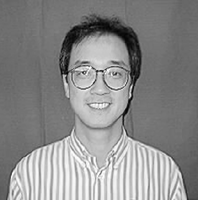Annual Meeting Organizers Deliver Remarkable Program for Puerto Rico
April 16, 2000

Puerto Rico organizing committee co-chairs Richard Tapia (above) and Tony Chan (below). The scope of the meeting, Chan points out, "ranges from analytical to computational, from IT to biology, from education to science policy. There is hopefully something new and interesting for everyone." Tapia, whose priorities for the meeting include "IT, K-12 education, and international activities," is particularly pleased that the meeting will be held in Puerto Rico, which has a well-deserved "fine reputation for what I would call seamless education."
From the SIAM President
Gilbert Strang
The Annual Meeting in July will be SIAM's first visit to Puerto Rico. Most of us will be seeing the island for the first time. I like the idea of combining mathematics with travel, and the program that Tony Chan and Richard Tapia have developed is exceptional. I would like to write about a few extraordinary parts of that program. SIAM's Web page will tell you about the other important parts (the lectures and minisymposia in applied mathematics!), and I am writing about extra things that you won't want to miss.
One is Ken Kennedy's invited lecture on information technology. In Tapia's words, this topic is absolutely the hottest in today's scientific world. IT has research components and educational components---and its connections to mathematics must remain strong. This does not happen automatically, as we all know. Kennedy co-chaired the President's PITAC Committee, and their report led to this year's largest scientific initiative (at NSF and five other agencies). I have written before about the constant efforts of SIAM and JPBM to make sure that computational mathematics is an integral part of this IT program. Ken Kennedy's presence at our Annual Meeting, speaking about research challenges as well as policy, is a chance to strengthen the connections between computational and computer science.
There is another point of intersection, this time between computation and education, where SIAM can be increasingly active. We could play a role at all levels, even by suggesting real problems to be used in mathematics courses. Three of the Puerto Rico speakers are leaders in international mathematics cooperation: Bill Schmidt is the director of the Third International Mathematics and Science Study, John Boright is from the U.S. National Research Council, and Manuel Gomez is vice president of the University of Puerto Rico. Most of us are not experts on education---but we know something from our own experience. We have ideas to share, probably more than we realize.
I must tell you about the von Neumann lecture and the community lecture. It is almost enough to report that they will be given by Persi Diaconis and Jamie Sethian. You know at once that those two lectures will be out of the ordinary. I always learn more than mathematics from such exceptional speakers. They make a SIAM meeting memorable.
And the good thing about the annual meeting is that one learns mathematics too. That is the key reason to attend and nobody forgets it. I hope you will allow me to close this column by describing a chance discovery---it may interest you, it may lead somewhere or nowhere; right now I mention it just for fun. Most of us have met the tridiagonal matrix that has ones above and below the main diagonal (where |i - j| = 1). You could make it finite or infinite or even periodic, but in all cases make it big. With zeros on the main diagonal, the eigenvalues are spread over the interval [-2,2]. What happens if you add a symmetric pair of ones, far from the diagonal but well into the interior of the matrix? MATLAB says that a new eigenvalue appears almost exactly at the square root of 5. The eigenvector differs completely from the usual oscillations---it has spikes at the positions i and j of the new off-diagonal ones. It might be nice to understand this matrix.

It will certainly be nice, personally and mathematically, to meet in Puerto Rico. We will have a resort hotel to ourselves and still be close to San Juan. A truly remarkable scientific program (from analysis to computation, over the whole range of applied mathematics) has been planned for the week of July 10 to 14.

